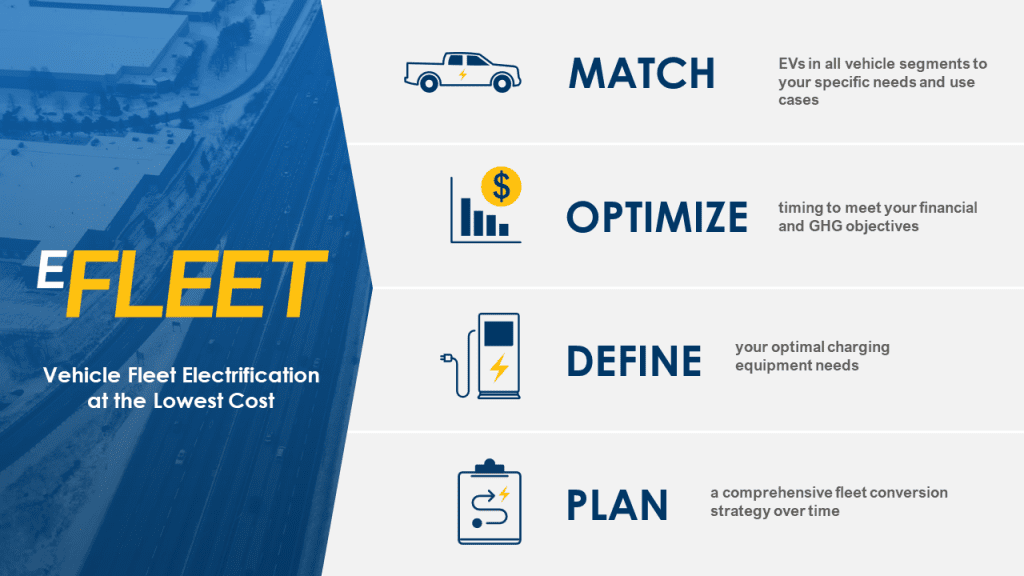The Business Case for Electrification
The electrification of vehicle fleets is rapidly underway. Converting your organization’s internal combustion engine vehicles to electric brings numerous benefits including the reduction of GHG emissions and lower operating costs . It also represents a significant investment that requires careful capital planning, organizational buy-in and an understanding of where the EV market is headed.
Drawing upon our leading experience helping organizations accelerate the adoption of clean mobility solutions, we developed a fleet electrification model that builds the business case for electrification by developing an optimized pathway grounded in solid analytics.
E-FLEETTM: Our Leading Fleet Electrification Model
Dunsky’s Fleet Electrification Optimization Model (E-FLEETTM) helps organizations convert their light, medium and heavy-duty vehicle fleets at the lowest cost. We do this by assessing hundreds to thousands of computations to determine the most cost-effective time to electrify each vehicle in a given fleet.
Since 2020, we have used E-FLEETTM to develop fleet electrification roadmaps for municipalities, governments, utilities and private companies in North America.
E-FLEETTM is ideal for fleets of any size and can accommodate a wide range of vehicle and equipment types and powertrain technologies. The model incorporates Dunsky’s vehicle and cost forecasts to assess not just what is feasible and cost-effective today, but what opportunities will materialize over time as the EV market evolves.
The model includes:
- Dunsky’s ZEV Availability Timeline: This will allow us to identify any technological constraints for the decarbonization of vehicles within the described timeframe and forecast when ZEV options become available for each vehicle type.
- Dunsky’s EV Price Forecast: includes our forecasted cost of vehicle replacements for internal combustion engine vehicles (ICEVs), BEVs, and PHEVs from 2022 to 2040 for all vehicle segments.
- Total Cost of Ownership (TCO): includes vehicle, maintenance, fuel and electricity costs, as well as carbon pricing.
- Fleet Optimization Algorithm: determines the optimal year for vehicle replacement based on vehicle TCO within the constraints of a fleet electrification or GHG reduction target (e.g., 100% light-duty ZEVs by 2035 or 80% reduction in GHG emissions by 2040). Our team of electrification experts works with stakeholders throughout an organization – from C-Suite to Finance to Fleet Operators, to understand the day-to-day reality of the organization and how the fleet is used.
Optimizing Investments in Charging Infrastructure
E-FLEET determines the charging infrastructure needed to support the fleet electrification roadmap. Working with fleet operators, and with a detailed understanding of fleet operations, we identify the optimal EV charging power level for each vehicle in the fleet and provide recommendations around load management and power sharing. We also work with facility operators to identify impacts to peak load for each facility where vehicles are housed and help clients understand whether electrical upgrades must be made.
Opportunities for Funding
Electrifying the transportation sector is a key to meeting net-zero targets for governments across North America. Dunsky is familiar with the evolving funding and subsidy landscape, having advised utilities and governments on the development of such programs. We can support your organization’s application process to ensure your fleet electrification roadmap receives eligible funding.
Contact Us for an Independent Assessment
Our fleet electrification clients benefit from dedicated team members who specialize in developing optimized roadmaps for clients. Our analysis is totally independent; Dunsky does not have financial ties to any vehicle or charging manufacturers, or lenders. If your organization is considering converting your vehicle fleet, contact us to learn more about how we can support your objectives.



